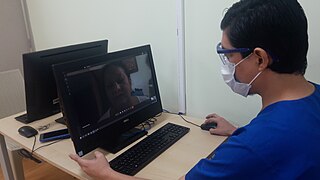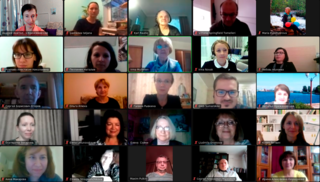
Remote work is the practice of working from one's home or another space rather than from an office.

Telehealth is the distribution of health-related services and information via electronic information and telecommunication technologies. It allows long-distance patient and clinician contact, care, advice, reminders, education, intervention, monitoring, and remote admissions. Telemedicine is sometimes used as a synonym, or is used in a more limited sense to describe remote clinical services, such as diagnosis and monitoring. When rural settings, lack of transport, a lack of mobility, conditions due to outbreaks, epidemics or pandemics, decreased funding, or a lack of staff restrict access to care, telehealth may bridge the gap as well as provide distance-learning; meetings, supervision, and presentations between practitioners; online information and health data management and healthcare system integration. Telehealth could include two clinicians discussing a case over video conference; a robotic surgery occurring through remote access; physical therapy done via digital monitoring instruments, live feed and application combinations; tests being forwarded between facilities for interpretation by a higher specialist; home monitoring through continuous sending of patient health data; client to practitioner online conference; or even videophone interpretation during a consult.
A learning management system (LMS) or virtual learning environment (VLE) is a software application for the administration, documentation, tracking, reporting, automation, and delivery of educational courses, training programs, materials or learning and development programs. The learning management system concept emerged directly from e-Learning. Learning management systems make up the largest segment of the learning system market. The first introduction of the LMS was in the late 1990s. LMSs have been adopted by almost all higher education institutions in the English-speaking world. Learning management systems have faced a massive growth in usage due to the emphasis on remote learning during the COVID-19 pandemic.

An online school teaches students entirely or primarily online or through the Internet. It has been defined as "education that uses one or more technologies to deliver instruction to students who are separated from the instructor and to support regular and substantive interaction between the students. Online education exists all around the world and is used for all levels of education. This type of learning enables the individuals to earn transferable credits, take recognized examinations, and advance to the next level of education over the Internet.

Videotelephony is the use of audio and video for real-time communication between people.

Digital rhetoric can be generally defined as communication that exists in the digital sphere. As such, digital rhetoric can be expressed in many different forms, including text, images, videos, and software. Due to the increasingly mediated nature of our contemporary society, there are no longer clear distinctions between digital and non-digital environments. This has expanded the scope of digital rhetoric to account for the increased fluidity with which humans interact with technology.

Social media are interactive technologies that facilitate the creation, sharing and aggregation of content, ideas, interests, and other forms of expression through virtual communities and networks. Although not unchallenged, common features include:

Telepsychiatry or telemental health refers to the use of telecommunications technology to deliver psychiatric care remotely for people with mental health conditions. It is a branch of telemedicine.

Digital Fashion is a field of fashion design that relies on 3D software or artificial intelligence to produce hyper-realistic, data-intensive digital 3D garment simulations that are digital-only products or digital models for physical products. Digital garments can be worn and presented in virtual environments, social media, online gaming, virtual reality (VR), and augmented reality (AR) platforms. The field contributes to the development of a more sustainable future for the fashion industry It has often been praised as an answer to ethical and creative concerns of traditional fashion by promoting innovation, reducing waste, and encouraging conscious consumption.

Digital Media in education is measured by a person's ability to access, analyze, evaluate, and produce media content and communication in a variety of forms. These media may involve incorporating multiple digital softwares, devices, and platforms as a tool for learning. The use of digital media in education is growing rapidly in today's age, competing with books for the leading form of communication. This form of education is slowly combating the traditional forms of education that have been around for a long time. With the introduction of virtual education, there has been a need for more incorporation of new digital platforms in online classrooms.

Media coverage of the COVID-19 pandemic has varied by country, time period and media outlet. News media has simultaneously kept viewers informed about current events related to the pandemic, and contributed to misinformation or fake news.

Zoom is a proprietary videotelephony software program developed by Zoom Video Communications. The free plan allows up to 100 concurrent participants, with a 40-minute time restriction. Users have the option to upgrade by subscribing to a paid plan, the highest of which supports up to 1,000 concurrent participants for meetings lasting up to 30 hours.

Social media became an active place to interact during the COVID-19 pandemic, following the onset of social distancing. Overall messaging rates had risen by above 50%, according to a study by Facebook's analytics department. Individuals at home used social media to maintain their relationships and access entertainment to pass time faster.

The COVID-19 pandemic has affected innumerable scientific and technical institutions globally, resulting in lower productivity in a number of fields and programs. However, the impact of the pandemic has also led to the opening of several new research funding lines for government agencies around the world.

Zoombombing or Zoom raiding is the unwanted, disruptive intrusion, generally by Internet trolls, into a video-conference call. In a typical Zoombombing incident, a teleconferencing session is hijacked by the insertion of material that is lewd, obscene, or racist in nature, typically resulting in the shutdown of the session or the removal of the troll. The term is especially associated with and is derived from the name of the Zoom videoconferencing software program, but it has also been used to refer to the phenomenon on other video conferencing platforms. The term became popularized in 2020 when the COVID-19 pandemic forced many people to stay at home, and videoconferencing came to be used on a large scale by businesses, schools, and social groups.

Pandemic fatigue is understood as a natural and expected reaction to sustained and unresolved adversity in people's everyday life. Those affected show symptoms of feeling burnt out and tired, while also expressing feelings of demotivation to engage in protection behaviors and seek COVID-19 related information as complacency, alienation and hopelessness.

The COVID-19 pandemic has created and popularized many terms relating to disease and videoconferencing.
Rehabilitation after COVID-19 is needed in individuals experiencing longer-term disabling illness at any stage of COVID-19 infection. The rehabilitation of individuals with COVID-19 includes screening for the need for rehabilitation, participation of a multi-disciplinary team to evaluate and manage the individual's disabilities, use of four evidence based classes for rehabilitation, as well as individualised interventions for other problems.

In 2020, school systems in the United States began to close down in March because of the spread of COVID-19. This was a historic event in the history of the United States schooling system because it forced schools to shut-down. At the very peak of school closures, COVID-19 affected 55.1 million students in 124,000 public and private U.S. schools. The effects of widespread school shut-downs were felt nationwide, and aggravated several social inequalities in gender, technology, educational achievement, and mental health.

Media fatigue is psychological exhaustion due to information overload from any form of media, though it is generally from news media and social media. The advent of the internet has contributed widely to media fatigue with vast amounts of information easily accessible and easily disseminated. Psychological exhaustion caused by media fatigue can lead to several negative outcomes, including emotional instability, increased stress, feeling overwhelmed, or experiencing sensory overload. Media fatigue can then lead to media avoidance, or intentional selectivity in the type and amount of media that is consumed.














